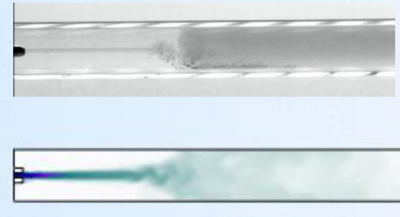My general research area is scientific computing, particularly in the areas of fundamental modeling of granular flows and multi-scale modeling of biochemical systems. My focus of research is powder technology with a concentration on process modeling and engineered particle processing. I intend to establish a strong research program in the area of multi-scale modeling with a focus on nano-pharmaceuticals and their application to biological systems. Moreover, I also focus on 3D printing technology in pharmaceutical industrial applications and lyophilization of therapeutic proteins. The following are some examples of my research interests.
(1) 3D printing of solid oral dosage tablets
The inkjet-based 3D printing method is used to print Pharmaceutical grade tablets. This research is also focusing on developing a fundamental understanding of the effect of critical materials attributes on the quality attributes of the printed tablets.
(2) Fundamental modeling (DEM) of granular flows : nature and industry
A good understanding of the physics of granular material is essential not only to design efficient handling and processing of material in various chemical industries but also in predicting landslides, avalanches, and soil erosion for change in sea-level. Granular material is idealized as a collection of frictional and inelastic spherical particles. Discrete element method (DEM), is widely used for computer simulation of mechanical behavior of granular material. We are currently using lab scale experiments and DEM modeling to predict both dynamics of natural systems and important industrial applications like granular drying, blending, granulation, and pharmaceutical coating.
Quantum scale calculations are incorporated in DEM algorithm pertinent to simulate bulk granular flow in order to predict the charge profiles in hopper chute assembly, confirm alteration of charge transfer capacities and validate the simulation data with the experimental results.
(3) Computational Fluid Dynamics (CFD)
Development of CFD based multi-component multiphase models for pharmaceutical and biomedical applications to gain insight into their various processes.
For pharmaceutical industry, the performance of mixers and the prediction of mixing achieved can be examined using CFD modeling work; the solid particle as near 60-80% of pharmaceutical products and its solid particle flows can be analyzed utilizing CFD model as well.
For lower energy cost and improve thermal efficiency in pharmaceutical industry, CFD-DEM coupled models are developed to numerically investigate hydrodynamic wet particles in fluidized bed with interstitial air flow to predict particle motions and pressure gradient.
CFD is used to model liposome formation which  used as the drug carrier in continuous manufacturing process. Both RANS and LES models were developed to model the turbulent jet in co-flow as this continuum approach.
used as the drug carrier in continuous manufacturing process. Both RANS and LES models were developed to model the turbulent jet in co-flow as this continuum approach.
The multiphase multicomponent aerol flow can be characterized using CFD model which we develop to investigate the decrease of drug retain issue in the commercial suspension based pMDI into a spacer.
(4) Molecular Modeling of Nanosystems
My interest is to develop high performance molecular modeling algorithms to gain a fundamental understanding of nanoscale transport and thermodynamics.
Molecular Dynamics (MD) approach is used to model the process of liposome formation. We develop force fields and compare the simulations from MARTINI, DRY-MARTINI, all-atom and coarse-grained MD to study lipid interactions in both ethanol and aqueous solvent.
(5) Multiscale modeling of transport in biological systems
Development of the software tools and mathematical approaches to integrate models from micro-scales to macro-scales in a seamless fashion is essential if we intend to build quantitatively predictive models of complex biological behaviors such as transdermal or pulmonary activity, embryonic development and cancer.